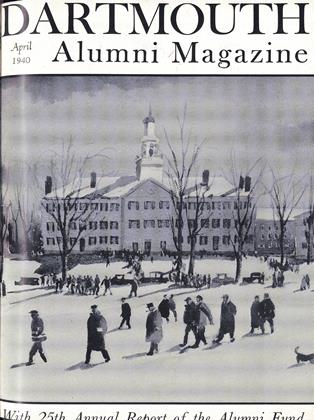(Modem Merchandise Management)Prof. Albert W. Frey '20. The RonaldPress Co. 1940. 429 pp. $4.50.
More than four years ago Professor Frey, in his course in Marketing, began to give recognition to the growth of Merchandising as a separate function in Manufacturing Companies.
He had come to realize, as had a few pioneering Companies, that there were certain parts of the Marketing operation which were primarily concerned with the merchandise itself (as Contrasted with the selling and the making of the merchandise).
Casting about for material he could find very little in the business literature of the day which treated of such operations as a group. Discussions about some of these operations were to be found in the Sales field, some in the Manufacturing and some in the Financial. The more difficulty he experienced in finding material the more convinced he was that a logical grouping of such functions or at least a recognition of their homogeneity should be profitable to any manufacturing establishment.
Thereupon he set out to define this new grouping which he called Merchandising or Merchandise Management, and to develop a series of papers on the several functions. Gradually the present book took shape.
It has many virtues. Drawn from the experiences of leading manufacturers in many fields, highlighted with references
from literally hundreds of sources in business literature, tempered by presentation to several groups of graduate students, it stands as a pioneer text in a field which has received relatively little attention up to now.
The scope of his work is indicated by some of the chapter titles:—"Pricing," "Quality," "Design-Style-Fashion," "Product Development," "Packaging," "Manufacturing Policies," "Merchandising Research." His illustrations vary from candy to automobiles, from dresses to refriotors, to shaving cream.
Surely in the wealth of ideas, actually tried in practice by hard-headed business men and faithfully recorded by the author' even the most casual reader will find something of value.
The book has a dual nature. It discusses not only organization but operation, not only policies but practices,—practices under all kinds of conditions. Yet through it all runs the continuing theme—"Organize for Merchandising." The first chapter defines the function and outlines its many parts. The last chapter offers several suggestions for organization and some suggestions about personnel requirements.
Professor Frey is not pedantic. He doesn't insist that all the Merchandise functions must be localized in one operating unit. But he does insist that recognition of the homogeneity of these functions will lead to better coordination, and hence to better profits.
This book should be on the "must" list of all executives interested in organization structure, in general management, in marketing, and even in manufacturing.
It should have equal value as a text book for advanced students in the Marketing field.
Spring Ski-ing Above Gulmarg. SomeK-2 Climbers' Impressions by George C. Sheldon '41 appears in the Annual for 1938-39 'he Ski Club of India.
The leading article in the Saturday Evening Post for March 16 is another article by Mr. Sheldon entitled Lost Behind theRanges.
Tristram Bent by Henry B. Safford '04, The White Stranger by Kimball Flaccus '33, More than Mere Living by H. Thompson Rich '15, and Come Spring by Ben Ames Williams '10 will be reviewed in later issues of the MAGAZINE.
 View Full Issue
View Full Issue
More From This Issue
-
 Article
ArticleRich Man's College?
April 1940 By JOHN HURD JR '21 -
 Article
ArticleMeet Bill Daniels—
April 1940 By CHARLES E. WIDMAYER '30 -
 Class Notes
Class Notes1930*
April 1940 By Chairman, ALBERT I. DICKERSON -
 Sports
SportsBig Green Teams
April 1940 By Whitey Fuller '37 -
 Class Notes
Class Notes1925*
April 1940 By Chairman, FORD H. WHELDEN -
 Class Notes
Class Notes1938*
April 1940 By Chairman, CARL F. VON PECHMANN
Books
-
 Books
BooksFACULTY PUBLICATIONS
March, 1922 -
 Books
BooksAlumni Articles
MAY 1971 -
 Books
BooksJAPAN: IMAGES AND REALITIES.
JANUARY 1970 By ALMON B. IVES -
 Books
BooksClose Encounters
DECEMBER 1984 By Frances T. Nye, M.D -
 BOOKS
BOOKSParty Crasher
MAY | JUNE 2018 By JULIA M. KLEIN -
 Books
BooksRENAISSANCE CONCEPTS OF METHOD.
June 1961 By WILLIS F. DONEY

